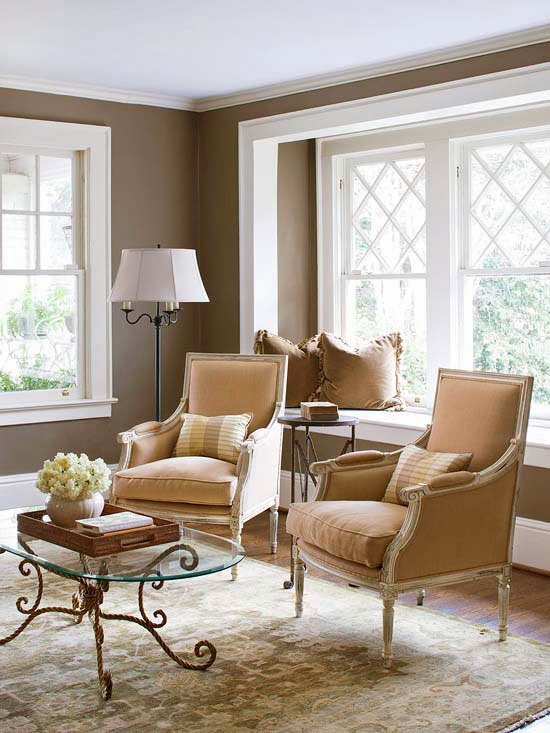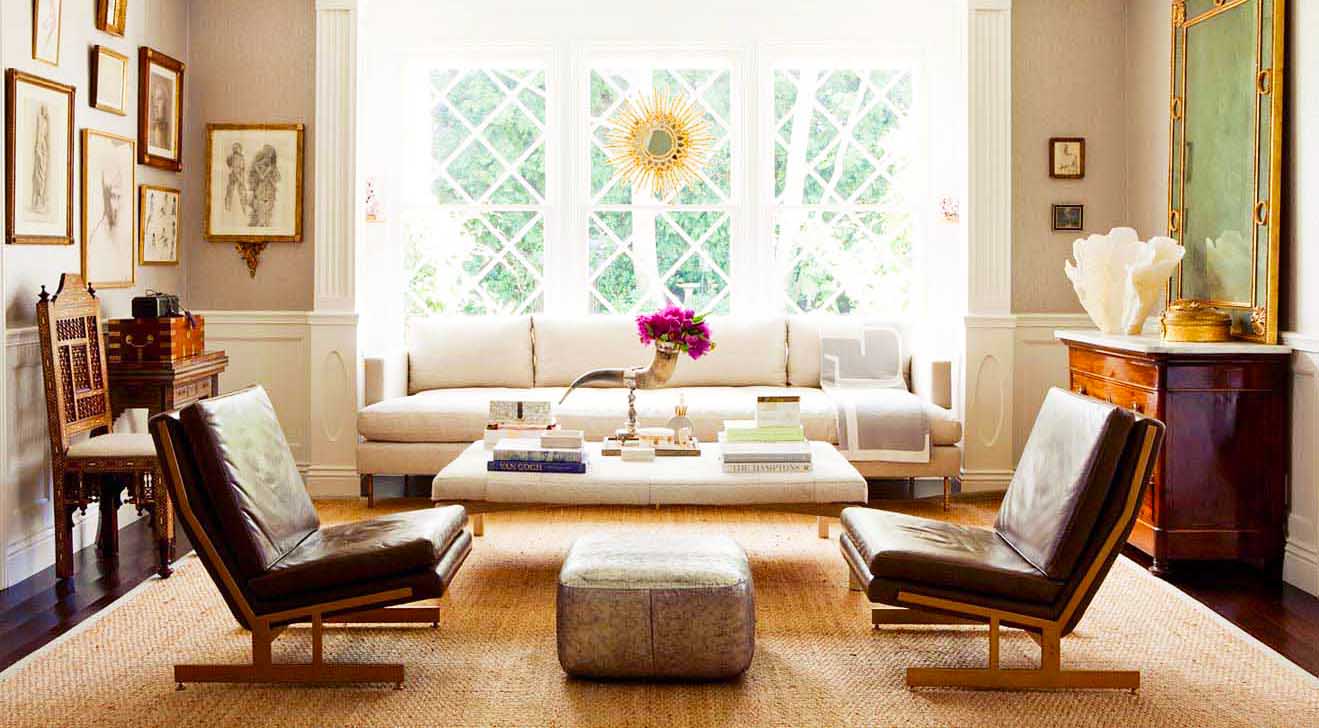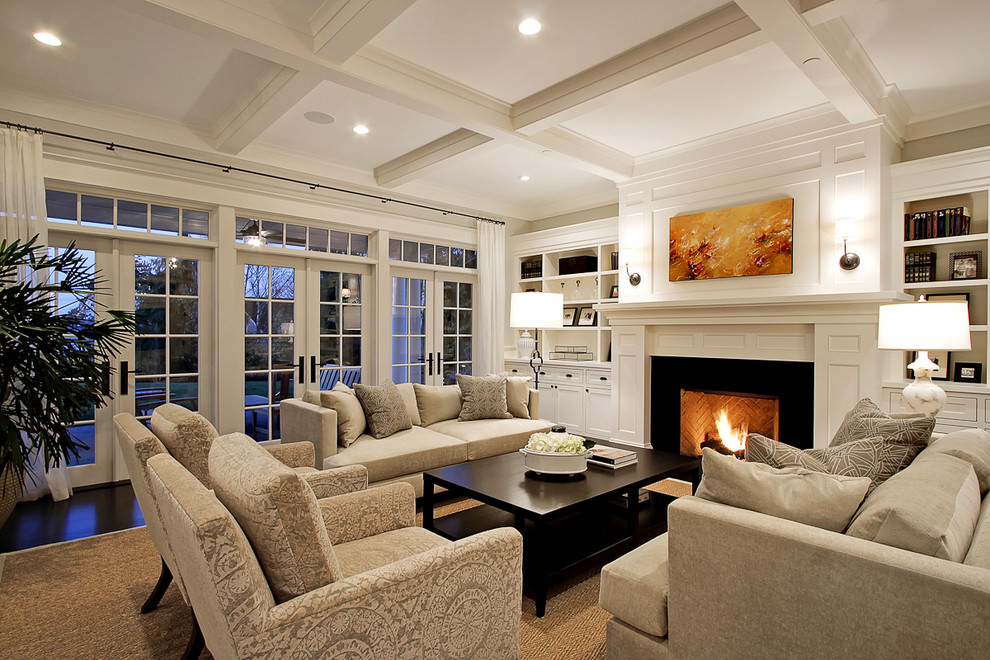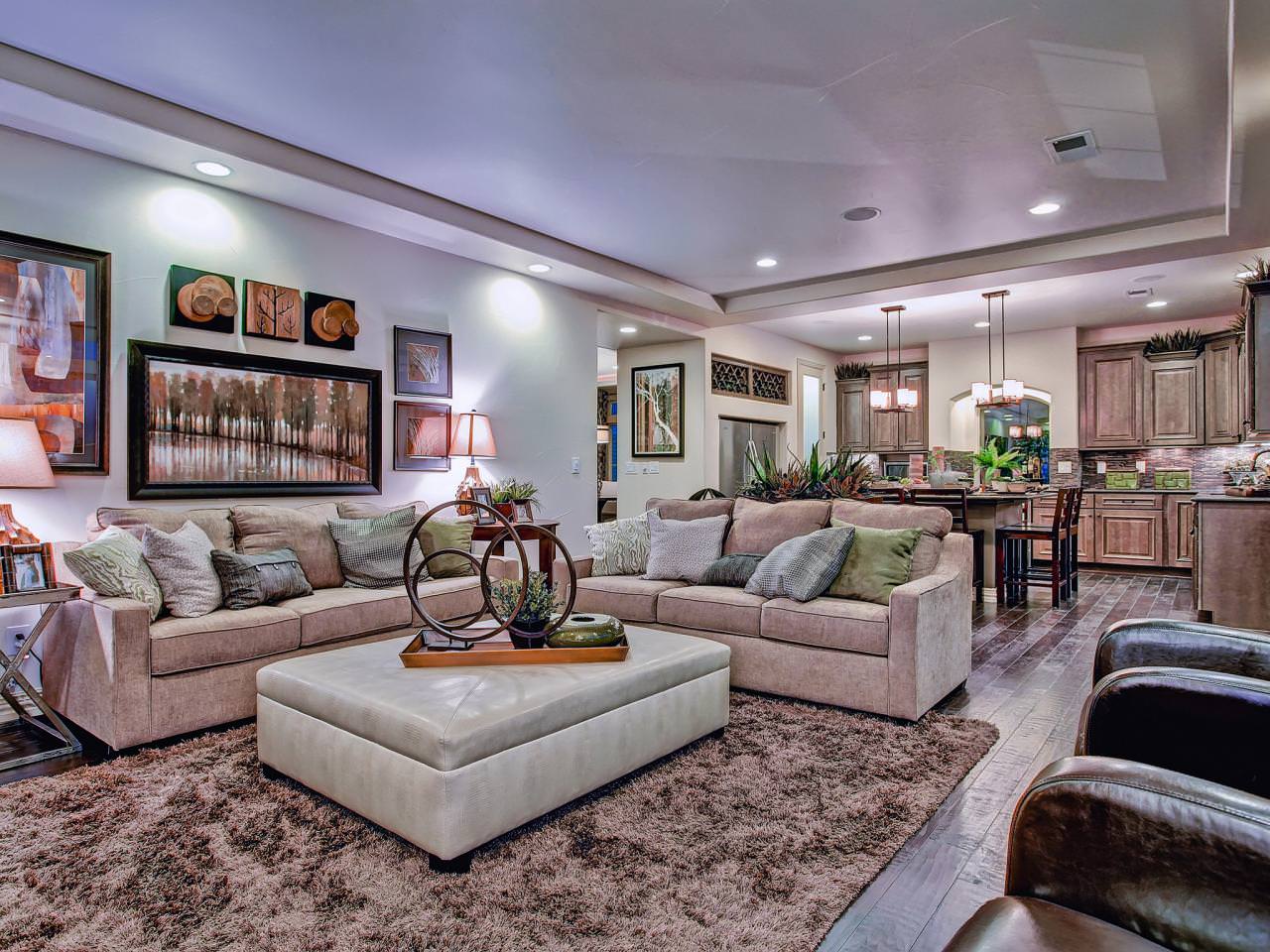Arranging furniture in a small living room can be a challenging task. With limited space, it's important to make every inch count and create a functional yet visually appealing layout. Here are some tips to help you make the most out of your small living room: 1. Measure the room and furniture: Before you start arranging your furniture, it's important to know the exact dimensions of your living room and the furniture pieces you have. This will help you determine what will fit and where. 2. Use multipurpose furniture: In a small living room, every piece of furniture should serve a purpose. Look for items that can double as storage, such as an ottoman with hidden storage or a coffee table with shelves or drawers. 3. Keep the traffic flow in mind: Make sure there is enough space for people to move around comfortably. Leave at least 3 feet of space between furniture pieces to create a clear path and avoid a cramped feeling. 4. Use light colors: Light colors can make a small living room feel more spacious and airy. Opt for light-colored furniture and walls to create the illusion of more space. 5. Consider the focal point: In a small living room, it's important to have a clear focal point to avoid a cluttered look. This could be a fireplace, a TV, or a piece of artwork. Arrange your furniture around the focal point to create a cohesive and visually appealing layout. Furniture Arrangement Tips for a Small Living Room
While having a large living room may seem like a dream, it can also be a challenge to arrange furniture in a way that feels cozy and inviting. Here are some tips to help you arrange furniture in a large living room: 1. Create zones: With a large living room, you have the advantage of creating different zones for different activities. Consider breaking up the space into a seating area, a reading nook, and a game corner. 2. Mix and match furniture: Don't be afraid to mix and match different furniture styles and shapes to create an interesting and visually appealing layout. This can also help break up the space and avoid a monotonous look. 3. Use area rugs: Area rugs can help define different zones and add warmth to a large living room. Make sure to choose the right size rug for the space and arrange furniture around it to create a cohesive look. 4. Add layers: In a large living room, it's important to add layers to create a cozy and inviting atmosphere. This can be achieved by adding throw pillows, blankets, and different textures to your furniture. 5. Don't forget about lighting: In a large living room, lighting is key. Make sure to have a mix of overhead lighting and lamps to create a well-lit and comfortable space. How to Arrange Furniture in a Large Living Room
There are endless possibilities when it comes to arranging furniture in a living room. Here are some ideas to help you get started: 1. Symmetrical arrangement: This is a classic and timeless way to arrange furniture in a living room. Place identical furniture pieces on either side of a focal point, such as a fireplace or a TV. 2. L-shaped arrangement: This is a great option for an open concept living room. Place a sectional sofa in an L-shape to create a cozy and functional seating area. 3. Conversation area: If your living room is used for entertaining, consider creating a conversation area. Place two sofas facing each other with a coffee table in between to encourage conversation. 4. Floating furniture: This is a great option for small living rooms. Instead of pushing furniture against the walls, float it in the middle of the room to create a more open and spacious feeling. 5. Use a rug as a guide: When arranging furniture, use a rug as a guide to define the space and create a cohesive look. Make sure the rug is large enough for all the furniture pieces to fit comfortably on it. Living Room Furniture Arrangement Ideas
Awkwardly shaped living rooms can be a design challenge, but with some clever furniture arrangement, you can make the most out of your space. Here are some tips to help you arrange furniture in an awkward living room: 1. Create a focal point: If your living room has an awkward shape, it's important to have a clear focal point to avoid a cluttered look. This could be a fireplace, a TV, or a piece of artwork. 2. Use versatile furniture: Look for furniture pieces that can serve multiple purposes, such as a storage ottoman or a coffee table with shelves. This can help you make the most out of your space. 3. Use light colors: Light colors can make a room feel more spacious and airy. Opt for light-colored furniture and walls to create the illusion of more space in your awkward living room. 4. Consider the traffic flow: Make sure there is enough space for people to move around comfortably. Leave at least 3 feet of space between furniture pieces to create a clear path and avoid a cramped feeling. 5. Experiment with different layouts: Don't be afraid to try out different furniture arrangements to find the one that works best for your awkward living room. You may be surprised by how different layouts can change the look and feel of your space. Tips for Arranging Furniture in an Awkward Living Room
A rectangular living room can be a tricky space to arrange furniture in. Here are some tips to help you create a functional and visually appealing layout: 1. Use an L-shaped sectional: This is a great option for a rectangular living room. Place a sectional sofa in an L-shape to create a cozy and functional seating area. 2. Add a focal point: Use a fireplace, a TV, or a piece of artwork as a focal point to anchor the room and create a cohesive look. 3. Consider traffic flow: Make sure there is enough space for people to move around comfortably. Leave at least 3 feet of space between furniture pieces to create a clear path and avoid a cramped feeling. 4. Use rugs to define different zones: If your rectangular living room is used for multiple purposes, use rugs to define different zones and create a cohesive look. 5. Don't push furniture against the walls: Instead of pushing furniture against the walls, try floating it in the middle of the room to create a more open and spacious feeling. How to Arrange Furniture in a Rectangular Living Room
A long and narrow living room can be a challenging space to arrange furniture in. Here are some tips to help you make the most out of your long narrow room: 1. Use a sectional sofa: A sectional sofa can be a great option for a long narrow room. Place it against one of the long walls to create a cozy and functional seating area. 2. Use versatile furniture: Look for furniture pieces that can serve multiple purposes, such as a storage ottoman or a coffee table with shelves. This can help you make the most out of your space. 3. Create a focal point: Use a fireplace, a TV, or a piece of artwork as a focal point to anchor the room and create a cohesive look. 4. Use rugs to define different zones: If your long narrow room is used for multiple purposes, use rugs to define different zones and create a cohesive look. 5. Don't push furniture against the walls: Instead of pushing furniture against the walls, try floating it in the middle of the room to create a more open and spacious feeling. Living Room Furniture Arrangement for a Long Narrow Room
An open concept living room can be a tricky space to arrange furniture in, as there are no clear boundaries. Here are some tips to help you create a functional and visually appealing layout for your open concept living room: 1. Use furniture to define zones: In an open concept space, furniture can be used to define different zones. Use a sofa or a console table to create a separation between the living room and the dining area. 2. Consider the flow of the room: Make sure there is enough space for people to move around comfortably. Leave at least 3 feet of space between furniture pieces to create a clear path and avoid a cramped feeling. 3. Use rugs to define different areas: Rugs can help define different zones and add warmth to an open concept living room. Make sure the rugs are large enough for all the furniture pieces to fit comfortably on them. 4. Create a focal point: Use a fireplace, a TV, or a piece of artwork as a focal point to anchor the room and create a cohesive look. 5. Don't be afraid to experiment: An open concept living room allows for more flexibility in furniture arrangement. Don't be afraid to try out different layouts to find the one that works best for your space. How to Arrange Furniture in an Open Concept Living Room
Arranging furniture in a living room with a fireplace and TV can be a bit tricky. Here are some tips to help you create a functional and visually appealing layout: 1. Decide on a focal point: In a room with both a fireplace and a TV, you need to decide which one will be the main focal point. This will determine how you arrange the furniture. 2. Use a sectional sofa: A sectional sofa can be a great option for a living room with a fireplace and TV. Place it against one of the walls to create a cozy and functional seating area. 3. Consider the viewing angle: Make sure that the seating area is arranged in a way that everyone has a good view of both the TV and the fireplace. 4. Use rugs to define different zones: Rugs can help define different zones and add warmth to the space. Make sure they are large enough for all the furniture pieces to fit comfortably on them. 5. Don't forget about lighting: Make sure to have a mix of overhead lighting and lamps to create a well-lit and comfortable space. Living Room Furniture Arrangement with Fireplace and TV
Arranging furniture in a square living room can be a bit challenging, as you want to make sure the space feels balanced and not too crowded. Here are some tips to help you create a functional and visually appealing layout: 1. Create a focal point: Use a fireplace, a TV, or a piece of artwork as a focal point to anchor the room and create a cohesive look. 2. Use a mix of furniture styles: Don't be afraid to mix and match different furniture styles and shapes to create an interesting and visually appealing layout. This can also help break up the space and avoid a monotonous look. 3. Use rugs to define different zones: Rugs can help define different zones and add warmth to the space. Make sure they are large enough for all the furniture pieces to fit comfortably on them. 4. Consider traffic flow: Make sure there is enough space for people to move around comfortably. Leave at least 3 feet of space between furniture pieces to create a clear path and avoid a cramped feeling. 5. Don't push furniture against the walls: Instead of pushing furniture against the walls, try floating it in the middle of the room to create a more open and spacious feeling. How to Arrange Furniture in a Square Living Room
Arranging furniture in a small living room can be a challenge, but with some creativity, you can make the most out of your space. Here are some tips to help you arrange furniture in a small living room: 1. Use multipurpose furniture: In a small living room, every piece of furniture should serve a purpose. Look for items that can double as storage, such as an ottoman with hidden storage or a coffee table with shelves or drawers. 2. Keep the traffic flow in mind: Make sure there is enough space for people to move around comfortably. Leave at least 3 feet of space between furniture pieces to create a clear path and avoid a cramped feeling. 3. Use light colors: Light colors can make a small living room feel more spacious and airy. Opt for light-colored furniture and walls to create the illusion of more space. 4. Consider the focal point: In a small living room, it's important to have a clear focal point to avoid a cluttered look. This could be a fireplace, a TV, or a piece of artwork. Arrange your furniture around the focal point to create a cohesive and visually appealing layout. Living Room Furniture Arrangement for a Small Space
Tips for Arranging Furniture in Your Living Room

Creating a Functional and Stylish Space
 When it comes to designing a living room,
furniture arrangement
can make all the difference. Not only does it affect the flow and functionality of the space, but it can also have a significant impact on the overall aesthetic. The
living room
is often the heart of the home, where families and guests gather to relax, socialize, and entertain. Therefore, it's essential to create a space that is both
functional
and
stylish
. Here are some
helpful tips
to consider when arranging furniture in your living room.
When it comes to designing a living room,
furniture arrangement
can make all the difference. Not only does it affect the flow and functionality of the space, but it can also have a significant impact on the overall aesthetic. The
living room
is often the heart of the home, where families and guests gather to relax, socialize, and entertain. Therefore, it's essential to create a space that is both
functional
and
stylish
. Here are some
helpful tips
to consider when arranging furniture in your living room.
Start with the Focal Point
 The first step in
arranging furniture
is to determine the
focal point
of the room. This could be a
fireplace
,
television
, or
large window
. Once you have identified the focal point, arrange your furniture around it. This will not only create a
balanced
and
harmonious
look, but it will also help to
maximize
the use of the space.
The first step in
arranging furniture
is to determine the
focal point
of the room. This could be a
fireplace
,
television
, or
large window
. Once you have identified the focal point, arrange your furniture around it. This will not only create a
balanced
and
harmonious
look, but it will also help to
maximize
the use of the space.
Consider the Functionality
 Before placing your furniture, think about how you will be using the living room. Will it be primarily for
relaxing
and
watching TV
, or will you be
entertaining
frequently? This will help you determine the best
layout
for your furniture. For example, if you will be using the space for
movie nights
, consider placing your
sofa
and
chairs
facing the television. If you will be
hosting parties
, opt for a more
open
and
conversational
layout.
Before placing your furniture, think about how you will be using the living room. Will it be primarily for
relaxing
and
watching TV
, or will you be
entertaining
frequently? This will help you determine the best
layout
for your furniture. For example, if you will be using the space for
movie nights
, consider placing your
sofa
and
chairs
facing the television. If you will be
hosting parties
, opt for a more
open
and
conversational
layout.
Think About Traffic Flow
 Another essential factor to consider when arranging furniture in your living room is the
traffic flow
. You want to make sure there is enough space for people to move around comfortably without
bumping
into furniture. Avoid placing furniture in
high traffic areas
and leave enough room for
doorways
to open and close easily.
Another essential factor to consider when arranging furniture in your living room is the
traffic flow
. You want to make sure there is enough space for people to move around comfortably without
bumping
into furniture. Avoid placing furniture in
high traffic areas
and leave enough room for
doorways
to open and close easily.
Don't Be Afraid to Mix and Match
 When it comes to
furniture
, there are no hard and fast rules. Don't be afraid to mix and match different
styles
and
shapes
. This can add
interest
and
dimension
to your living room. However, make sure to
maintain
a sense of
cohesion
by incorporating
similar
colors or
textures
throughout the space.
When it comes to
furniture
, there are no hard and fast rules. Don't be afraid to mix and match different
styles
and
shapes
. This can add
interest
and
dimension
to your living room. However, make sure to
maintain
a sense of
cohesion
by incorporating
similar
colors or
textures
throughout the space.
Consider Functionality and Style
 When selecting
furniture
for your living room, it's essential to find a balance between
functionality
and
style
. While you want your furniture to be
comfortable
and
practical
, it should also add to the overall
design aesthetic
of the room. Consider
multi-functional pieces
such as
ottomans
with hidden storage or
coffee tables
with shelves.
When selecting
furniture
for your living room, it's essential to find a balance between
functionality
and
style
. While you want your furniture to be
comfortable
and
practical
, it should also add to the overall
design aesthetic
of the room. Consider
multi-functional pieces
such as
ottomans
with hidden storage or
coffee tables
with shelves.
Experiment with Different Arrangements
 Don't be afraid to experiment with different
arrangements
until you find the one that works best for your living room. Move pieces around and try different
layouts
to see what looks and feels
right
. Remember, the
arrangement
of your furniture can always be changed, so don't be afraid to get creative and
mix things up
.
In conclusion,
furniture arrangement
is a crucial aspect of
interior design
that can greatly impact the functionality and aesthetics of a living room. By considering the focal point, functionality, traffic flow, and mixing and matching different styles, you can create a space that is both functional and stylish. Don't be afraid to experiment and have fun with your furniture arrangement until you find the perfect fit for your living room.
Don't be afraid to experiment with different
arrangements
until you find the one that works best for your living room. Move pieces around and try different
layouts
to see what looks and feels
right
. Remember, the
arrangement
of your furniture can always be changed, so don't be afraid to get creative and
mix things up
.
In conclusion,
furniture arrangement
is a crucial aspect of
interior design
that can greatly impact the functionality and aesthetics of a living room. By considering the focal point, functionality, traffic flow, and mixing and matching different styles, you can create a space that is both functional and stylish. Don't be afraid to experiment and have fun with your furniture arrangement until you find the perfect fit for your living room.































:max_bytes(150000):strip_icc()/arrange-furniture-awkward-living-room-5194365-hero-6738bbe71fea4187861db7ad9afbad44.jpg)












/arrange-furniture-awkward-living-room-5194365-hero-6738bbe71fea4187861db7ad9afbad44.jpg)




















































